
I N S I G H T
Saivite Creed: Twelve Potent Verses Expounding the Essence of Saivism
EVERY RELIGION HAS A CREED OF ONE form or another, an authoritative formulation of its beliefs. Historically, creeds have developed whenever religions migrate from their homelands. Until then, the beliefs are fully contained in the culture and taught to children as a natural part of growing up. A creed is the distillation of volumes of knowledge into a series of easy-to-remember beliefs. A creed is meant to summarize the explicit teachings or articles of faith, to imbed and thus protect and transmit the beliefs. Creeds give strength to individuals seeking to understand life and religion. Creeds also allow members of one faith to express, in elementary and consistent terms, their traditions to members of another.
Though the vast array of doctrines within Hinduism has not always been articulated in summary form, from ancient times unto today we have the well-known creedal mahavakya, “great sayings,” of the Vedic Upanishads. Now, in this technological age in which village integrity is being replaced by worldwide mobility, the importance of a creed becomes apparent if religious identity is to be preserved. We need two kinds of strength—that which is found in diversity and individual freedom to inquire and that which derives from a union of minds in upholding the universal and shared principles of our faith.
Saivism is truly ageless, for it has no beginning. It is the precursor of the many-faceted religion now termed Hinduism. Scholars trace the roots of Siva worship back more than 8,000 years to the advanced Indus Valley civilization. But sacred writings tell us there never was a time when Saivism did not exist. Modern history records six main schools: Saiva Siddhanta, Pasupatism, Kashmir Saivism, Vira Saivism, Siddha Siddhanta and Siva Advaita. Saivism’s grandeur and beauty are found in a practical culture, an enlightened view of man’s place in the universe and a profound system of temple mysticism and yoga. It provides knowledge of man’s evolution from God and back to God, of the soul’s unfoldment and awakening guided by enlightened sages. Like all the sects, its majority are families, headed by hundreds of orders of swamis and sadhus who follow the fiery, world-renouncing path to moksha. The Vedas state, “By knowing Siva, who is hidden in all things, exceedingly fine, like film arising from clarified butter, the One embracer of the universe—by realizing God, one is released from all fetters.”
The twelve beliefs on the following pages embody the centuries-old central convictions of Saivism, especially as postulated in Saiva Siddhanta, one of the six schools of Saivism. They cover the basic beliefs about God, soul and world, evil and love and more. On the last page is a glossary of words used in the twelve beliefs.
 Belief One
Belief One
REGARDING GOD’S UNMANIFEST REALITY
Siva’s followers all believe that Lord Siva is God, whose Absolute Being, Parasiva, transcends time, form and space. The yogi silently exclaims, “It is not this. It is not that.” Yea, such an inscrutable God is God Siva. Aum.
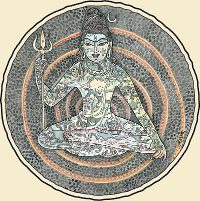 Belief Two
Belief Two
REGARDING GOD’S MANIFEST NATURE OF ALL-PERVADING LOVE
Siva’s followers all believe that Lord Siva is God, whose immanent nature of love, Parashakti, is the substratum, primal substance or pure consciousness flowing through all form as energy, existence, knowledge and bliss. Aum.
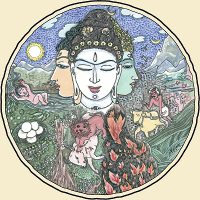 Belief Three
Belief Three
REGARDING GOD AS PERSONAL LORD AND CREATOR OF ALL
Siva’s followers all believe that Lord Siva is God, whose immanent nature is the Primal Soul, Supreme Mahadeva, Paramesvara, author of Vedas and Agamas, the creator, preserver and destroyer of all that exists. Aum.
 Belief Four
Belief Four
REGARDING THE ELEPHANT-FACED DEITY
Siva’s followers all believe in the Mahadeva Lord Ganesha, son of Siva-Shakti, to whom they must first supplicate before beginning any worship or task. His rule is compassionate. His law is just. Justice is His mind. Aum.
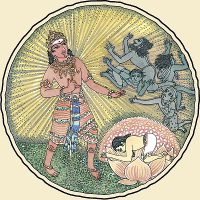 Belief Five
Belief Five
REGARDING THE DEITY KARTTIKEYA
Siva’s followers all believe in the Mahadeva Karttikeya, son of Siva-Shakti, whose vel of grace dissolves the bondages of ignorance. The yogi, locked in lotus, venerates Murugan. Thus restrained, his mind becomes calm. Aum.
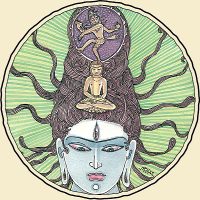 Belief Six
Belief Six
REGARDING THE SOUL’S CREATION AND IDENTITY WITH GOD
Siva’s followers all believe that each soul is created by Lord Siva and is identical to Him, and that this identity will be fully realized by all souls when the bondage of anava, karma and maya is removed by His grace. Aum.
 Belief Seven
Belief Seven
THE GROSS, SUBTLE AND CAUSAL PLANES OF EXISTENCE
Siva’s followers all believe in three worlds: the gross plane, where souls take on physical bodies; the subtle plane, where souls take on astral bodies; and the causal plane, where souls exist in their self-effulgent form. Aum.
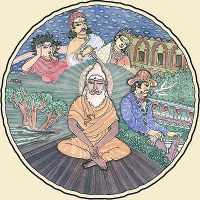 Belief Eight
Belief Eight
REGARDING KARMA, SAMSARA AND LIBERATION FROM REBIRTH
Siva’s followers all believe in the law of karma—that one must reap the effects of all actions he has caused—and that each soul continues to reincarnate until all karmas are resolved and moksha, liberation, is attained. Aum.
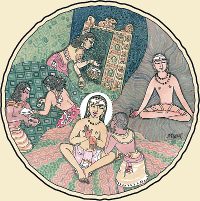 Belief Nine
Belief Nine
REGARDING THE FOUR MARGAS, STAGES OF INNER PROGRESS
Siva’s followers all believe that the performance of charya, virtuous living, kriya, temple worship, and yoga, leading to Parasiva through the grace of the living satguru, is absolutely necessary to bring forth jnana, wisdom. Aum.
 Belief Ten
Belief Ten
REGARDING THE GOODNESS OF ALL
Siva’s followers all believe there is no intrinsic evil. Evil has no source, unless the source of evil’s seeming be ignorance itself. They are truly compassionate, knowing that ultimately there is no good or bad. All is Siva’s will. Aum.
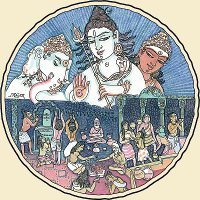 Belief Eleven
Belief Eleven
REGARDING THE ESOTERIC PURPOSE OF TEMPLE WORSHIP
Siva’s followers all believe that religion is the harmonious working together of the three worlds and that this harmony can be created through temple worship, wherein the beings of all three worlds can communicate. Aum.
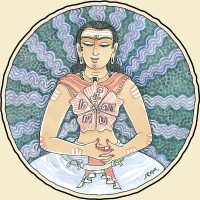 Belief Twelve
Belief Twelve
REGARDING THE FIVE LETTERS
Siva’s followers all believe in the Panchakshara Mantra, the five sacred syllables “Namasivaya,” as Saivism’s foremost and essential mantra. The secret of Namasivaya is to hear it from the right lips at the right time. Aum.

Vedas study: A father and his two sons chant Vedic mantras together outside their adobe dwelling during their daily practice sessions.
The Four Stages of Saivism
The path of enlightenment is divided naturally into four stages or padas: charya, virtue and selfless service; kriya, worshipful sadhanas; yoga, meditation under a guru’s guidance; and jnana, the state of enlightened wisdom reached toward the path’s end as a result of Self Realization through the Guru’s grace. These four padas are quite similar to the four yogas of Vedanta: karma yoga, bhakti yoga, raja yoga and jnana yoga. However, there is one key difference. Whereas in Vedanta you can choose to follow just one of the yogas, in the Saiva Siddhanta school of Saivism we need to pass through all four stages, or padas.
Let’s say the path of life is rocks across a shallow stream. Vedanta gives us four separate rock paths to choose from, one for each of the four yogas, all of which lead across the river. Saiva Siddhanta gives us one path for crossing the river which consists of four stones: charya, kriya, yoga and jnana.
The four stages are not alternative ways, but progressive, cumulative phases of a one path, much like the natural development of a butterfly from egg to caterpillar, from caterpillar to pupa, and then the final metamorphosis to butterfly. The four stages are what each human soul must pass through in many births to attain its final goal of moksha, freedom from rebirth. In the beginning stages, we suffer until we learn. Learning leads us to service; and selfless service is the beginning of spiritual striving. Service leads us to understanding. Understanding leads us to meditate deeply and without distractions. Finally meditation leads us to surrender in God. This is the straight and certain path, the San Marga, leading to Self Realization, the inmost purpose of life.
Charya Pada
Charya, literally “conduct,” is the first stage of religiousness and the foundation for the next three stages. It is also called the dasa marga, meaning “path of servitude,” for here the soul relates to God as servant to master. The disciplines of charya include humble service, attending the temple, performing one’s duty to community and family, honoring holy men, respecting elders, atoning for misdeeds and fulfilling the ten classical restraints called yamas which are: noninjury, truthfulness, nonstealing, divine conduct, patience, steadfastness, compassion, honesty, moderate appetite and purity. It is the stage of overcoming basic instinctive patterns such as the tendencies to become angry and hurtful. Right behavior and self-sacrificing service are never outgrown. The keynote of charya, or karma yoga, is seva, religious service given without the least thought of reward, which has the magical effect of softening the ego and bringing forth the soul’s innate devotion.
Kriya Pada
Saivism demands deep devotion through bhakti yoga in the kriya pada, the softening of the intellect and unfolding love. In kriya, the second stage of religiousness, our sadhana, or regular spiritual discipline, which was mostly external in charya, is now also internal. Kriya, literally “action or rite,” is a stirring of the soul in awareness of the Divine, overcoming the instinctive-intellectual mind. We now look upon the Deity image not just as carved stone, but as the living presence of the God. We perform ritual and puja not because we have to but because we want to. We are drawn to the temple to satisfy our longing. We sing joyfully. We absorb and intuit the wisdom of the Vedas and Agamas. We perform pilgrimage and fulfill the sacraments. We practice diligently the ten classical observances called niyamas which are: remorse, contentment, giving, faith, worship of the Lord, scriptural listening, cognition, sacred vows, recitation and austerity. Our relationship with God in kriya is as a son to his parents.
Yoga Pada
Yoga, “union,” is the process of uniting with God within oneself, a stage arrived at through perfecting charya and kriya. God is now like a friend to us. This system of inner discovery begins with asana—sitting quietly in yogic posture—and pranayama, breath control. Pratyahara, sense withdrawal, brings awareness into dharana, concentration, then into dhyana, meditation. Over the years, under ideal conditions, the kundalini fire of consciousness ascends to the higher chakras, burning the dross of ignorance and past karmas. Dhyana finally leads to enstasy—the contemplative experience of Satchidananda, God as energy-bliss, and ultimately to nirvikalpa samadhi, the experience of God as Parasiva, timeless, formless, spaceless. Truly a living satguru is needed as a steady guide to traverse this path. When yoga is practiced by one perfected in kriya, the Gods receive the yogi into their midst through his awakened, fiery kundalini, or cosmic energy within every individual.
Jnana Pada
Jnana is divine wisdom emanating from an enlightened being, a soul in its maturity, immersed in Sivaness, the blessed realization of God, while living out earthly karma. Jnana is the fruition of yoga and tapas, or intense spiritual discipline. Through yoga one bursts into the superconscious mind, experiencing bliss, all-knowingness and perfect silence. It is when the yogi’s intellect is shattered that he soars into Parasiva and comes out a jnani, a knower. Each time he enters that unspeakable nirvikalpa samadhi, he returns to consciousness more and more the knower. He is the liberated one, the jivanmukta, the epitome of kaivalya—perfect freedom—far-seeing, filled with light, filled with love. One does not become a jnani simply by reading and understanding philosophy. The state of jnana lies in the realm of intuition, beyond the intellect.